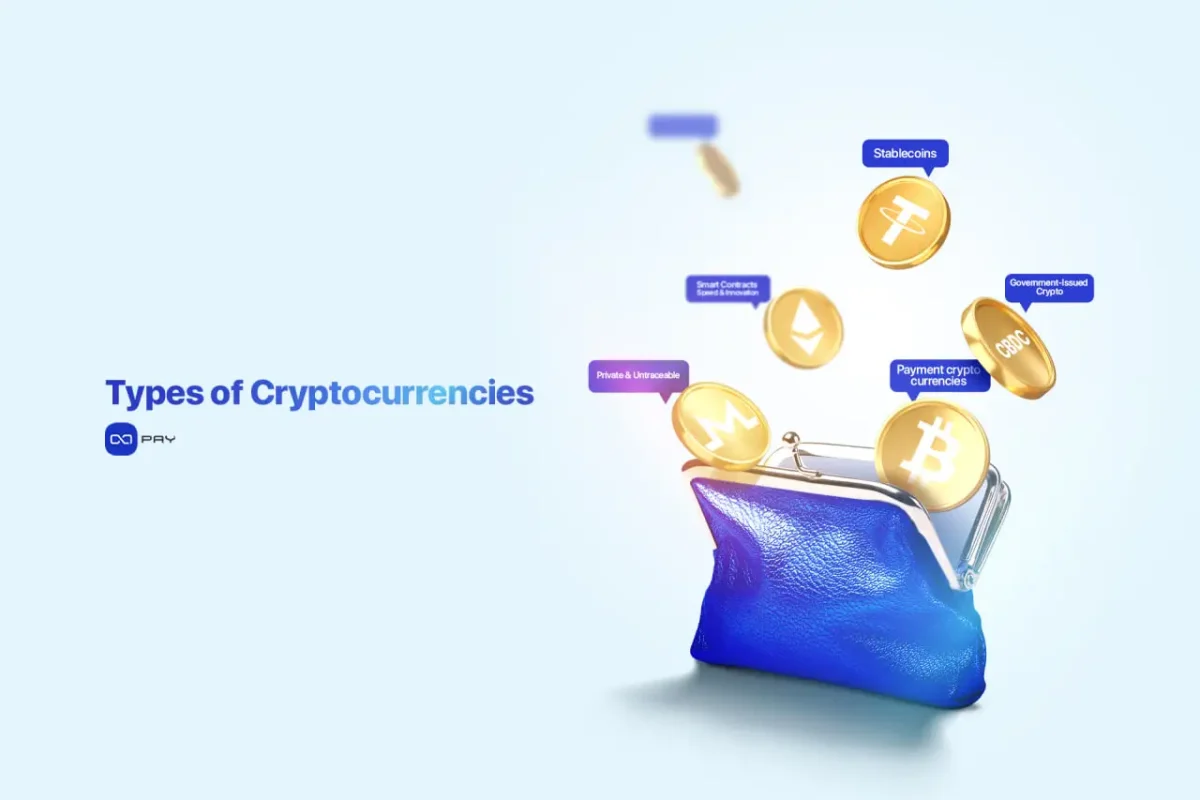加密货币已成为传统金融的实用替代方案,支持全球交易、新型投资形式以及去中心化金融工具。自2009年比特币诞生以来,成千上万的数字资产应运而生,每种资产都有其独特的设计、用途和技术。本指南探讨了不同类型的加密货币,从比特币到稳定币和隐私代币,并展示了人们如何通过诸如 OxaPay以及更广泛地参与加密生态系统。
什么是加密货币?
加密货币是数字或虚拟货币,使用 加密 进行安全交易。与由中央银行控制的传统法定货币不同,加密货币在名为区块链的去中心化网络上运行。这种去中心化的特性确保了透明度、安全性和金融自主性,使交易无需银行等中介机构。
简单解释: 加密货币就像可以在线使用的数字货币。这些数字货币受到密码保护,并由共享网络存储,确保任何个人或组织都无法控制它们。.
什么是区块链?
A 区块链 就像一本公共日记,每个人都可以看到,但没有人可以删除。它能安全地跟踪每一笔交易,确保透明度和安全性。每笔交易都会作为一个新的 "区块 "添加到链上,形成永久的防篡改记录。这项技术是所有加密货币的基础,可在无信任环境中实现信任。
需要了解的关键术语:
- 分散式: 不受任何中央机构控制。
- 密码学 使用密码保护信息的方法。
- 采矿: 利用功能强大的计算机制造新硬币的过程。
- 钱包 安全存储加密货币的数字应用程序或设备。
- 智能合约: 将条款直接写入代码的自动化合同。
- 押注: 通过在钱包中持有加密货币获得奖励。
- 产量农业: 通过出借或抵押加密资产获取回报。
加密货币简史
虽然数字货币的概念是在 20 世纪 90 年代通过以下项目出现的 DigiCash 和 比特金, 直到2009年,由化名“中本聪”(Satoshi Nakamoto)的比特币才标志着第一个真正意义上的去中心化加密货币。自那时起,加密货币领域迅速发展。例如,以太坊引入了智能合约,莱特币则提供了更快的交易速度。此外,像Tether这样的稳定币似乎旨在应对价格波动,而像门罗币和Zcash这样的隐私币则优先考虑匿名性。如今,加密货币的用途已超越支付领域,通过DeFi平台、NFT和全球数字资产推动各个领域的创新。.

加密货币类型
加密货币可分为几种类型,每种类型都有不同的特点和用例。无论是用于投资、日常交易还是探索新技术,了解这些类型对于根据特定需求选择合适的加密货币都至关重要。
比特币 (BTC):第一种加密货币
比特币 比特币是最初的加密货币,至今仍是最广为人知的数字资产。比特币常被称为 "数字黄金",它的诞生是为了作为传统法定货币的去中心化替代品。它在传统法定货币的基础上运行。比特币是以 工作证明(PoW)区块链矿工在这里验证交易,确保网络安全。
初学者须知:
比特币就像网络版的现金。你可以把它发送给全球任何人,而不需要银行,但比特币的数量永远只有 2100 万个,这有助于保持其价值。
替代币及其在加密货币生态系统中的作用
另类币指的是比特币以外的所有加密货币。这些币通常旨在应对特定挑战或引入比特币不具备的新功能。
以太坊 (ETH):
就像一个数字应用程序商店、 以太坊 允许开发者使用智能合约构建去中心化应用程序(dApps)。它从 PoW 过渡到 赌注证明 机制,提高可扩展性并降低能耗。
莱特币(LTC):
被称为比特币的更快表亲, 莱特币 提供更快的交易时间和不同的哈希算法,使其更适合较小的交易。
瑞波币(XRP):
类似于全球银行转账系统,专注于快速、低成本的跨境交易。Ripple 技术被金融机构广泛用于国际汇款。
其他山寨币:
包括 Cardano (ADA)、Polkadot (DOT) 和 Solana (SOL),每个都针对特定行业,例如 去中心化金融(DeFi) 和 非同质化代币(NFT).
稳定币:Tether(USDT)、USD Coin(USDC)
稳定币是一种加密货币,旨在通过与美元或黄金等传统资产挂钩来维持稳定的价值。这些数字资产兼具法定货币的稳定性和加密货币的优势,例如快速交易和全球可及性。
简单类比:
稳定币就像数字美元,其价值接近 $1,在动荡的加密货币市场中提供了安全的避风港。. Tether (USDT) 和 美元硬币(USDC) 是最广泛使用的稳定币之一,常用于交易和作为汇款媒介。
Meme 币:狗狗币 (DOGE)、柴犬 (SHIB)
模因币 最初只是网络笑话,但由于社区支持和社交媒体的炒作,获得了现实世界的价值。例如,狗狗币最初是作为恶搞而创建的,但现在已被广泛用于微交易和在线打赏。
初学者见解:
Meme币就像网络表情包一样,由于过于流行而变成了真正的货币。它们的价值通常由网络趋势而非技术创新或强大的用例驱动。
隐私币:门罗币(XMR)、Zcash(ZEC)
隐私币优先考虑匿名性和不可追踪的交易。与比特币不同,比特币的交易在区块链上公开可见,而隐私币则使用先进的加密技术来隐藏交易细节。
门罗币(XMR):
通过隐藏发送者、接收者和交易金额来实现完全匿名。
大零币(ZEC):
提供透明和屏蔽交易,允许用户选择他们喜欢的隐私级别。
这些货币对于重视保密的用户来说特别有吸引力,尽管它们也因潜在的滥用而面临监管审查。
实用代币和安全代币
实用代币:
这些代币可以访问区块链生态系统中的特定服务,就像一张音乐会门票一样。例如,币安币 (BNB) 在币安的交易平台上提供较低的手续费。
安全令牌:
代表对现实世界资产(例如股票、房地产或债券)的所有权。这些代币通常需要遵守监管规定,因此它们类似于传统证券,但采用数字形式。
中央银行数字货币(CBDC)
CBDC 是一国法定货币的数字形式,由中央银行发行和监管。其目标是将加密货币的安全性和效率与传统金融体系的稳定性和监管相结合。
CBDC 的示例:
- 数字人民币(中国): 目前正在进行大规模试验,目标是实现现金交易数字化。
- 数字欧元(欧洲): 欧洲中央银行提议对欧元区的支付基础设施进行现代化改造。
- 电子克朗(瑞典): 为实物现金提供数字补充的试点项目。
CBDC 可以改变货币政策的实施方式,提高支付效率,改善金融包容性。

加密货币之间的主要区别
加密货币的底层技术、交易速度、费用和用例差异巨大。了解这些差异可以帮助用户根据自身需求选择最佳的加密货币,无论是用于投资、交易还是探索去中心化金融 (DeFi)。
1. 共识机制:工作量证明(PoW) vs. 权益证明(PoS)
- 工作量证明(PoW): 需要算力通过挖矿来验证交易。比特币和莱特币就采用这种方法,安全但耗能。
- 权益证明(PoS): 与挖矿不同,验证者是根据其持有的代币数量以及愿意“质押”作为抵押品来选择的。以太坊 2.0 和 Cardano 采用了这种方法,更加节能且可扩展。
2. 交易速度和费用
不同加密货币的交易速度和成本差异很大。例如:
- 比特币 每笔交易大约需要 10 分钟,费用根据网络需求而波动。
- 以太坊 在 15 秒内处理交易,但在网络拥堵期间 gas 费用可能会很高。
- 瑞波币(XRP): 以几乎即时的交易和最低的费用而闻名,使其成为跨境支付的理想选择。
- 稳定币: 例如 USDT 和 USDC,提供快速交易和可预测的成本。
3. 主要加密货币对比表
| 加密货币 | 协商一致机制 | 交易速度 | 主要用例 |
| 比特币 (BTC) | 工作证明 | 约 10 分钟 | 价值存储、支付 |
| 以太坊 (ETH) | 股权证明 | ~15秒 | 智能合约、DeFi |
| 瑞波币(XRP) | 共识协议 | ~4秒 | 跨境支付 |
| Tether (USDT) | 稳定币 | 快速地 | 稳定的价值储存 |
加密货币的实际用途
加密货币已超越数字支付范畴,在各行各业提供多样化的应用。以下是一些最实际的用途:
日常支付和电子商务
许多企业,包括大型在线零售商,都接受加密货币作为支付方式。微软、AT&T 和 Overstock 等公司都已集成加密货币支付,允许客户使用比特币和其他数字资产购买商品和服务。 支付网关 OxaPay 使企业能够无缝地将加密支付集成到他们的系统中,扩大他们的客户群并降低交易费用。
投资和交易机会
加密货币已成为热门的投资类别,提供交易和长期持有的机会。交易者利用币安、Coinbase 和 Kraken 等交易所买卖和持有加密货币。此外,诸如 质押 和 收益耕作 允许投资者通过参与去中心化金融(DeFi)平台赚取被动收入。
跨境交易和汇款
加密货币实现了快速且低成本的国际汇款。传统汇款服务通常收取高额费用且需要数天才能处理,而加密货币可以以最低的成本实现即时交易。瑞波币 (XRP) 和 Tether (USDT) 等稳定币在这方面尤其受欢迎。
商业应用:使用 OxaPay 接受加密支付
对于企业来说, 接受加密货币支付 提供一种降低交易成本、避免退款并满足全球受众需求的方法。 OxaPay 提供无缝集成的工具和 API,使企业能够高效安全地管理付款。OxaPay 提供欠款覆盖和付款人付费等功能,帮助企业顺利处理交易,即使在部分付款的情况下也是如此。
去中心化金融(DeFi)与慈善捐款
DeFi 平台使用智能合约提供金融服务,例如借贷和赚取利息,无需传统银行介入。慈善机构也能从加密货币捐赠中受益,因为加密货币捐赠透明度高,交易成本更低。像 捐赠区块 使非营利组织能够接受比特币和其他加密货币的捐赠,从而有效地支持全球事业。
加密货币入门:你需要知道的一切
许多新手一开始接触加密货币时会感到畏惧。然而,通过遵循清晰的循序渐进的方法,他们可以简化流程,并逐渐建立信心。
初学者分步指南
1. 选择可靠的钱包:
根据您的安全性和可访问性需求,选择托管或非托管钱包。Coinbase Wallet 和 MetaMask 等钱包是初学者的热门选择。
2. 使用值得信赖的交易所:
在 Binance、Coinbase 或 Kraken 等信誉良好的交易所注册,以安全地购买、出售和交易加密货币。
3. 遵循安全最佳实践:
始终启用双重身份验证 (2FA),创建强密码,并避免共享私钥。Ledger 和 Trezor 等硬件钱包可为长期存储提供额外的安全性。
4. 保持知情:
通过可靠来源了解市场趋势、监管变化和新的加密货币项目,例如 CoinDesk, CoinTelegraph和 加密石板.
扩展安全提示
- 避免网络钓鱼诈骗: 警惕那些要求您提供加密钱包信息的未经请求的消息、电子邮件或链接。
- 使用硬件钱包进行长期存储: 硬件钱包离线存储您的加密货币,保护它们免受黑客攻击和在线威胁。
通过遵循这些步骤,初学者可以安全地探索加密货币的世界,最大限度地降低风险,同时最大限度地提高潜在回报。
加密货币的好处和风险
加密货币拥有诸多优势,但也伴随着风险。了解风险和利弊对于做出明智的决策至关重要。
优点:
- 财务自主: 用户可以完全控制自己的资产,而无需银行等中介机构。
- 降低交易费用: 尤其有利于跨境支付,与传统金融服务相比降低成本。
- 透明度和安全性: 区块链技术确保交易透明且防篡改。
- 创新潜力: 加密货币支持新的金融产品和服务,包括去中心化金融(DeFi)和非同质化代币(NFT)。
缺点:
- 波动性: 加密货币价格可能会大幅波动,从而导致潜在的财务损失。
- 监管挑战: 加密货币的法律地位因国家而异,新的法规可能会影响市场稳定。
- 安全风险: 虽然区块链是安全的,但个人账户和钱包可能容易受到黑客攻击和盗窃。
- 技术壁垒: 浏览数字钱包、交易所和私钥需要学习曲线,这对初学者来说可能具有挑战性。
为了降低风险,投资者和用户应该采取最佳安全措施,分散投资组合,并随时了解监管发展。
结论
在持续创新和各行各业广泛应用的推动下,加密货币领域正在迅速扩张。如今,全球用户超过 4 亿,数字资产已不再是空谈,而是服务于从跨境支付到资产代币化的现实需求。因此,越来越多的企业开始使用 OxaPay 等工具来安全高效地接受加密货币。此外,随着 Layer 2 扩展和区块链互操作性等趋势的兴起,理解和应用加密货币对个人和企业而言都具有明显的战略优势。.
开始使用 OxaPay 加密网关 今天就为您的企业做好迎接全球金融未来的准备。




